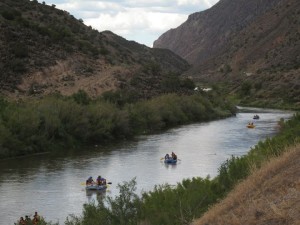*This article is not a substitute for the advice of an attorney.*
This week I will be in Medford, Massachusetts presenting on the Texas v. New Mexico battle over the Rio Grande at the University Council of Water Resources conference. As part of my preparation for my presentations, I thoroughly reviewed the briefing filed in the Supreme Court by all parties in this case. Today, I will review New Mexico’s Motion to Dismiss. Texas’ Response is expected in the coming week and I will provide a review of the Texas arguments once available.
On April 30, 2014, New Mexico filed a Motion to Dismiss the complaints filed by both Texas and the United States in the Texas v. New Mexico suit pending at the United States Supreme Court. New Mexico claims that Texas’ complaint fails to state a claim upon which relief may be granted and, therefore, should be dismissed by the Supreme Court. Here are the highlights from New Mexico’s Motion to Dismiss. If anyone would like a copy of the motion, please contact me and I will be happy to email it to you.
Basic Background
This lawsuit involves a dispute between Texas and New Mexico over the waters of the Rio Grande River. In 1916, the Bureau of Reclamation began operating the Rio Grande Project, which was to provide irrigation water to areas in Texas and New Mexico. The project built the Elephant Butte Reservoir and entered into contracts with two project beneficiaries–the Elephant Butte Irrigation District and the El Paso County Water Improvement District No. 1. After ongoing disputes between the states, Texas, New Mexico, and Colorado entered into an interstate compact regarding the waters of the Rio Grande in 1938. The Compact, which was ratified by each state’s legislature and approved by Congress, requires Colorado to deliver a certain amount of water to New Mexico at the Colorado/New Mexico state line and New Mexico to deliver a certain amount of water to Texas at the Elephant Butte Reservoir, located 105 miles north of the Texas/New Mexico border.
Texas claims New Mexico has violated the compact by allowing surface water diversions and groundwater pumping permits between the Elephant Butte Reservoir and the Texas State line, thereby decreasing the water actually delivered to Texas pursuant to the Compact. Due to the interest of the Rio Grande Project, the United States has intervened as a party to the lawsuit essentially siding with Texas. (To read more on the lawsuit, click here).
New Mexico’s Arguments
In its Motion to Dismiss, New Mexico argues the following main points: (1) The Rio Grande Compact imposed no state-line delivery obligation upon New Mexico; (2) The Compact includes no requirement for New Mexico to preserve conditions on the Rio Grande between Elephant Butte and the Texas/New Mexico state-line as they existed in 1938; (3) Texas failed to state a claim under the Compact–rather any claim that water is not being adequately delivered to the state-line is a claim under the Rio Grande Project; and (4) Any claim that there is insufficient water for Project beneficiaries should be brought in a more proper forum by the beneficiaries or the United States.
First, New Mexico argues Texas does not, and cannot, point to any specific Compact clause requiring New Mexico to make any deliveries at the state-line. Instead, the Compact requires New Mexico to make deliveries at Elephant Butte and the parties do not dispute it has done so as required. New Mexico claims Texas’ argument that the “spirit and purpose” of the agreement obligates New Mexico to do anything at the state line is simply inaccurate based on the terms of the Compact. Further, New Mexico makes clear had Congress intended to require state-line deliveries under the Compact, it clearly knew how to write such express language. New Mexico offers the example of the Compact itself, which requires Colorado to deliver water at the New Mexico line, and points to other treaties with similar terms.
Second, New Mexico claims Texas offers no evidence the Compact imposed a requirement that New Mexico maintain 1938 conditions on the Rio Grande south of Elephant Butte. In support of this argument, New Mexico offers three key pieces of evidence. First, New Mexico offers letters written during Compact negotiations between an attorney for a water association and Compact Commissioner Frank Clayton. The attorney wrote, “I do not find anything in the compact, however, which ties down and limits the use or diversion of the waters below Elephant Butte according to present uses and physical conditions.” Commissioner Clayton responded, “the question of the diversion of the water released from Elephant Butte reservoir is taken care of by contracts between the districts under the Rio Grande Project and the Bureau of Reclamation.” Next, New Mexico again points to language in other treaties expressly requiring unchanged conditions as proof that had Congress wished to require this, it knew how to do so. For example, the Pecos River Compact of 1949 provides, “New Mexico shall not deplete by man’s activities the flow of the Pecos River at the New Mexico-Texas state line below an amount which will give to Texas a quantity of water equivalent to that available to Texas under the 1947 conditions.” Even more on point is a predecessor to the Rio Grande Compact, a temporary compact entered by Texas, New Mexico, and Colorado, which included the following language, “New Mexico agrees…that she will not cause or suffer the water supply of the Elephant Butte Reservoir to be impaired by new or increased diversion or storage within the limits of New Mexico unless and until such storage depletion is offset by increase of drainage return.” This language was omitted from the final 1938 Compact, indicating the parties’ intend and understanding that no obligation to maintain 1938 conditions existed in the final agreement. Finally, New Mexico argues Texas’ own actions show the Compact does not require maintenance of conditions. For example, the City of El Paso owns and operates the Canutillo well field just east of the Rio Grande along the New Mexico-Texas border, which EBID claims illegally intercepts water belonging in New Mexico.
Third, New Mexico argues to the extent that project beneficiaries are not receiving adequate water as provided for under the Project, the beneficiaries have a claim against the United States as the project manager, not against New Mexico under the Compact. Similarly, if New Mexico, as the project manager and a senior water rights holder, believes it is not receiving all the water to which it is entitled, it has the right to instigate a priority call through the State Engineer to curtail junior water rights. This type of priority call–upon investigation by the State Engineer–could require the curtailment of users, both groundwater and surface water, junior to the Project.












